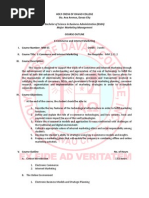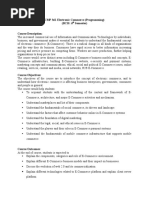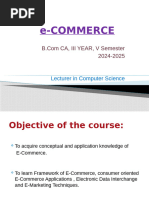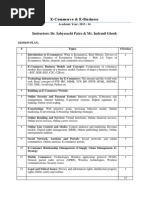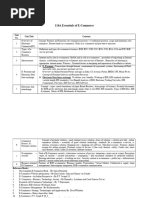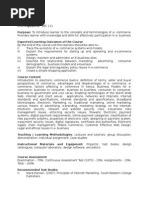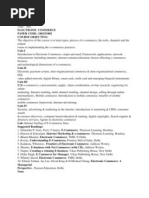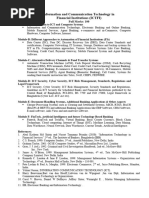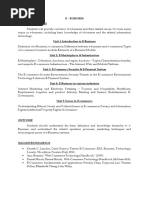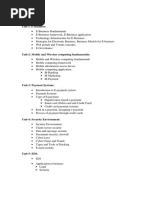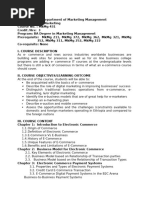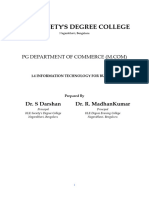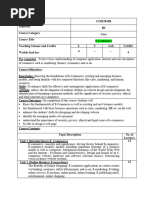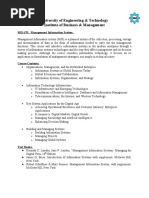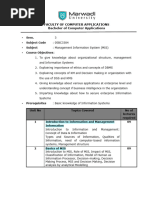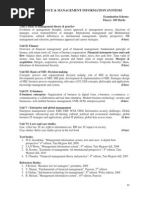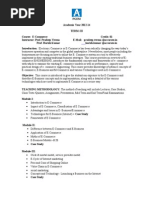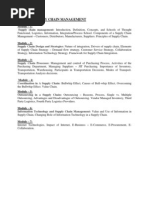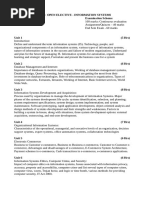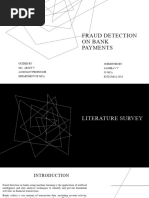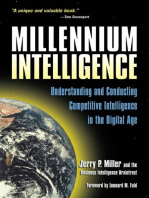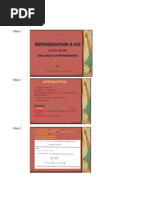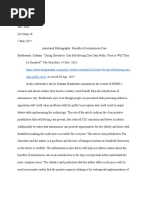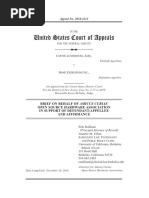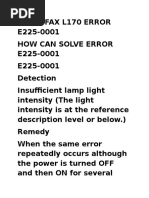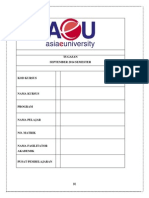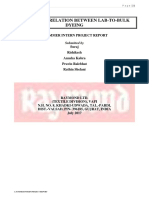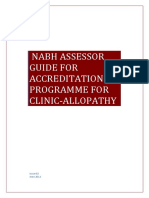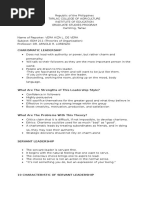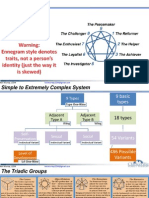It 41
It 41
Uploaded by
रवींद्र वैद्यCopyright:
Available Formats
It 41
It 41
Uploaded by
रवींद्र वैद्यOriginal Description:
Original Title
Copyright
Available Formats
Share this document
Did you find this document useful?
Is this content inappropriate?
Copyright:
Available Formats
It 41
It 41
Uploaded by
रवींद्र वैद्यCopyright:
Available Formats
SEMESTER IV
TRACK III: INFORMATION MANAGEMENT & QUALITY CONTROL
Sr.
No.
4.
Subject
Code
T3-IT41
Subject Title
E -Commerce & Knowledge
Management
Internal
External
30
70
Objectives:
To understand the concepts & role of e-commerce and Knowledge Management in organizations.
To get introduced to the key themes of techniques & technology to realize more value from
knowledge assets.
%
Sr.
Topic Details
No. of Sessions
Weightage
No
1
Introduction to e-commerce:
Meaning, nature and scope; channels of e-commerce,
Business applications of e-commerce, Traditional
commerce vs. E-commerce, Business model of e12
5
commerce: B2B, B2C, C2C,B2G and other models of ecommerce. The internet technology background,
categories of network, switching techniques, Internet
service provider, virtual private network
2
Mobile commerce:
Introduction to M-Commerce ,History & Key Benefits &
8
3
limitations, Critical Success factors, Wireless
Application protocol(WAP),Mobile banking.
3
Electronic payment system:
Type of payment systems- e-cash and currency servers,
e- cheques, credit card, smart card, electronic purses and
15
7
debit cards, operational, credit and legal risks of epayments, risk management options for e-payment
system, order fulfillment for e-commerce.
4
Security issues in e-commerce:
Security risk of e-commerce, type and sources of threats;
protecting the electronic commerce assets and
intellectual property; firewalls; client server network
15
5
security; data and message security; digital identification
and electronic signature; encryption approach to e
commerce security.
5
Introduction to Knowledge Management (KM)
History of Knowledge Management, Types of
Knowledge, The Knowledge Management Processes,
20
8
Knowledge Management Systems, Organizational
impact on knowledge management, Factors influencing
Knowledge Management.
6
Knowledge Management Technologies and systems
Knowledge Application Systems, Knowledge Capture
15
6
Systems, Knowledge sharing systems and Knowledge
Discovery Systems.
7
Knowledge Management Tools
Knowledge capture and creation tools, Knowledge
Sharing and Dissemination Tools, Knowledge
15
6
Acquisition and application tools. Practical implications
of KM tools and techniques.
128
The KM team: KM roles and Responsibilities within
organizations, Future challenges for KM.
Reference Books
1. E-Commerce concept-model-strategies, C.S.V. Murthy, Himayalaya Publication House
2. Electronic commerce, Elias M. Awad., PHI
3. Knowledge Management, Donald Hislop, Oxford University Press, 2nd edition
4. E-Commerce concepts and applications, Nidhi Dhawan,International book house Pvt Ltd.
5. Knowledge management, Systems and Processes, IRMA Becerra- Fernandez, Rajiv Sabherwal,
PHI edition.
6. Knowledge Management, Elias M. Awad and Hassan Ghaziri, Pearson, fourth impression
7. Knowledge Management in Theory and Practice,Kimiz Dalkir,Elsevier
8. Frontiers of Electronic commerce, Kalkota and Whinston, Pearson
9. E-commerce, Joseph, PHI second edition
129
You might also like
- E Commerce and Internet Marketing Course OutlineDocument5 pagesE Commerce and Internet Marketing Course Outlinetortomato80% (5)
- Spurious Correlations PDFDocument9 pagesSpurious Correlations PDFJanice Leriorato0% (1)
- BFS and DFSDocument22 pagesBFS and DFSRajendranbehappy75% (4)
- Vernon J. Bourke - History of Ethics. 2-Doubleday (1970) PDFDocument155 pagesVernon J. Bourke - History of Ethics. 2-Doubleday (1970) PDFZoran Pervan100% (1)
- E-Commerce and E-governanceDocument2 pagesE-Commerce and E-governanceshivamNo ratings yet
- KS - C - CC-365 E-Commerce and E-Governance PDFDocument3 pagesKS - C - CC-365 E-Commerce and E-Governance PDFjfkddeio100% (1)
- CMP 361 Electronic Commerce (Programming) (BCIS: 6 Semester)Document3 pagesCMP 361 Electronic Commerce (Programming) (BCIS: 6 Semester)Spandan KcNo ratings yet
- E-Commerce III Year V Semester PPT 2024Document15 pagesE-Commerce III Year V Semester PPT 2024ramdas charlapallyNo ratings yet
- Lesson Manual Cs462Document4 pagesLesson Manual Cs462Kapil GurjargourNo ratings yet
- E Commerce & E BusinessDocument2 pagesE Commerce & E Businesschetanking40No ratings yet
- E-Commerce Lesson Plan PDFDocument2 pagesE-Commerce Lesson Plan PDFSabyasachi Patra100% (1)
- E-Commerce - Code-305 - BCA - Sem. VDocument172 pagesE-Commerce - Code-305 - BCA - Sem. VNipunNo ratings yet
- Digital Economy Bcis New CourseDocument3 pagesDigital Economy Bcis New CourseJoshan PradhanNo ratings yet
- Harmbe University College Program: Masters of Business AdministrationDocument3 pagesHarmbe University College Program: Masters of Business Administrationአረጋዊ ሐይለማርያምNo ratings yet
- SyllabusDocument3 pagesSyllabusduality bbwNo ratings yet
- Class NotesDocument2 pagesClass Notesnishantrajput03333No ratings yet
- E-Commerce Course OutlineDocument2 pagesE-Commerce Course OutlinePrimo CloudNo ratings yet
- E CommerceDocument2 pagesE CommerceAnubhav LuthraNo ratings yet
- E-Commerce MBA 4th SemDocument1 pageE-Commerce MBA 4th SemSiddhartha Sankar BiswasNo ratings yet
- Course Title: E-CommerceDocument4 pagesCourse Title: E-CommerceNabaraj NegiNo ratings yet
- BBM 7th Sem Syllabus 2016 PDFDocument23 pagesBBM 7th Sem Syllabus 2016 PDFBhuwan100% (1)
- 1805136965-PG - ITSM 3 & 4 semDocument11 pages1805136965-PG - ITSM 3 & 4 semrohanNo ratings yet
- ICTFIDocument1 pageICTFI290 582 Md. NayeemNo ratings yet
- CSC370 E-Commerce (Elective II)Document3 pagesCSC370 E-Commerce (Elective II)Biplov SapkotaNo ratings yet
- Course Objectives: E - BusinessDocument1 pageCourse Objectives: E - Businessgomsan7No ratings yet
- E Business Fundamentals 208922848Document11 pagesE Business Fundamentals 208922848Sebby GillNo ratings yet
- Business Skills For E-CommerceDocument7 pagesBusiness Skills For E-Commercea7zanal3mer_303No ratings yet
- E-Commerce SyllabusDocument2 pagesE-Commerce Syllabusnovexas410No ratings yet
- E commerce courseoutlineDocument3 pagesE commerce courseoutlineSolomon DawitNo ratings yet
- Chaudhary Charan Singh University, MeerutDocument4 pagesChaudhary Charan Singh University, MeerutSatyarth PundirNo ratings yet
- Course Outcomes:: 19-202-0708 Mobile Application DevelopmentDocument10 pagesCourse Outcomes:: 19-202-0708 Mobile Application Developmentpipatec675No ratings yet
- E-Commerce Course OutlineDocument2 pagesE-Commerce Course OutlineDebu JacksonNo ratings yet
- Information Technology For BusinessDocument77 pagesInformation Technology For Businessvasu pradeepNo ratings yet
- Marketing: (Philip Kotler) : ST NDDocument5 pagesMarketing: (Philip Kotler) : ST NDksrash18No ratings yet
- Information Technology For Business Full NotesDocument76 pagesInformation Technology For Business Full Notesvasu pradeepNo ratings yet
- Course Break Up E-CommerceDocument2 pagesCourse Break Up E-Commerceaimanashgar81No ratings yet
- MIS-GP AssignmentDocument3 pagesMIS-GP AssignmentSSEKIMPI BadruNo ratings yet
- Course Code: MGBIT 20401 Credit Units: 04 Course Objective:: OmmerceDocument3 pagesCourse Code: MGBIT 20401 Credit Units: 04 Course Objective:: OmmerceRicha AgarwalNo ratings yet
- Dmgt505 Management Information SystemDocument272 pagesDmgt505 Management Information SystemPalkaNo ratings yet
- E-Business SyllabusDocument1 pageE-Business Syllabus23mbat04No ratings yet
- UG B.com English 10231-E-CommerceDocument226 pagesUG B.com English 10231-E-Commercevidyaramesh9904No ratings yet
- 6th Semester Course Carriculam (MKT-15)Document8 pages6th Semester Course Carriculam (MKT-15)tajmirul RahmanNo ratings yet
- MBA - Information Technology ManagementDocument14 pagesMBA - Information Technology Managementswapnilm250102100% (1)
- E Commerce Unit1Document31 pagesE Commerce Unit1laaybaNo ratings yet
- University of Engineering & Technology Institute of Business & ManagementDocument1 pageUniversity of Engineering & Technology Institute of Business & ManagementiqraNo ratings yet
- EContent 7 2024 07 02 15 20 25 05BC3304MIS4pdf 2024 07 02 12 36 29Document4 pagesEContent 7 2024 07 02 15 20 25 05BC3304MIS4pdf 2024 07 02 12 36 29yuvraj6704No ratings yet
- E BusinessDocument8 pagesE Businessdjd_461No ratings yet
- Management Information Systems: Course Code: MBAMS 10201 Credit Units: 03 Course ObjectiveDocument1 pageManagement Information Systems: Course Code: MBAMS 10201 Credit Units: 03 Course ObjectiveSonu DonNo ratings yet
- Value Added 1stDocument1 pageValue Added 1staazimahmadsheikh1156No ratings yet
- Fmis TeDocument1 pageFmis TeMonzieAirNo ratings yet
- ECOM1Document4 pagesECOM1pawan_019No ratings yet
- Mba 3073 Supply Chain Management: Module - 1Document6 pagesMba 3073 Supply Chain Management: Module - 1Sachin RoyNo ratings yet
- Syllabus of Cyber Security - Topics List V1.0Document6 pagesSyllabus of Cyber Security - Topics List V1.0751kps100% (1)
- Information SystemsDocument2 pagesInformation SystemsmaheshNo ratings yet
- University of Nairobi: School of Business Department of Management Science MBA (SEP-DEC 2020) Dis511: Information SystemsDocument2 pagesUniversity of Nairobi: School of Business Department of Management Science MBA (SEP-DEC 2020) Dis511: Information SystemsBenardMbithiNo ratings yet
- SVKM's NMIMS University Mukesh Patel School of Technology Management & EngineeringDocument3 pagesSVKM's NMIMS University Mukesh Patel School of Technology Management & EngineeringmgordhandasNo ratings yet
- Project ZeroDocument15 pagesProject Zerosandravinod033No ratings yet
- Course Outline: International Islamic University MalaysiaDocument5 pagesCourse Outline: International Islamic University MalaysiaAmirul AsyrafNo ratings yet
- Shaazims@sunway - Edu.my: Teaching Plan BIS2204 Electronic CommerceDocument3 pagesShaazims@sunway - Edu.my: Teaching Plan BIS2204 Electronic CommerceCharmaine TehNo ratings yet
- Millennium Intelligence: Understanding and Conducting Competitive Intelligence in the Digital AgeFrom EverandMillennium Intelligence: Understanding and Conducting Competitive Intelligence in the Digital AgeRating: 3 out of 5 stars3/5 (2)
- E-commerce Evolution : Navigating Trends and Innovations in Digital MarketingFrom EverandE-commerce Evolution : Navigating Trends and Innovations in Digital MarketingNo ratings yet
- The Jack Roller: A Delinquent Boy's Own Story ReviewDocument4 pagesThe Jack Roller: A Delinquent Boy's Own Story ReviewCarola González0% (1)
- Grading System Be PDFDocument7 pagesGrading System Be PDFDanish PawaskarNo ratings yet
- Sesimis Design in Steel Session 14 - Braced FramesDocument63 pagesSesimis Design in Steel Session 14 - Braced FramesAlfonso BautistaNo ratings yet
- Air RefrigerationDocument10 pagesAir Refrigerationعبدالله عمرNo ratings yet
- Iot Based Solar Monitoring and Tracking SystemDocument12 pagesIot Based Solar Monitoring and Tracking SystemGowri ManognaNo ratings yet
- IEEE Standard For A High Performance Serial Bus PDFDocument392 pagesIEEE Standard For A High Performance Serial Bus PDFdanghoang1987No ratings yet
- Gain-Public-Trust: GuardianDocument5 pagesGain-Public-Trust: Guardianapi-358647204No ratings yet
- Curver Luxembourg v. Home Expressions - Amicus Brief (The Open Source Hardware Association)Document31 pagesCurver Luxembourg v. Home Expressions - Amicus Brief (The Open Source Hardware Association)Sarah BursteinNo ratings yet
- Canon Fax l170 Error E225Document2 pagesCanon Fax l170 Error E225Tariq Majeed100% (1)
- Oral Language Kindergarten Handout PDFDocument1 pageOral Language Kindergarten Handout PDFvivianediniz.caNo ratings yet
- Assignment - Mis For ProtonDocument26 pagesAssignment - Mis For ProtonAhmad Hirzi Azni0% (2)
- Corelation Between Lab and BulkDocument38 pagesCorelation Between Lab and BulkSuraj Raghv0% (1)
- Nabh Assessor Guide For Accreditation Programme For Clinic-AllopathyDocument12 pagesNabh Assessor Guide For Accreditation Programme For Clinic-AllopathyRamesh PatelNo ratings yet
- EDM 211 Charismatic, Servant and Shared LeadershipDocument4 pagesEDM 211 Charismatic, Servant and Shared LeadershipAlfie Clores BallesterosNo ratings yet
- Marshall, Petrosino Martin (2010)Document17 pagesMarshall, Petrosino Martin (2010)Hob151219!No ratings yet
- Do Pretty Women Inspire Men To Discount The FutureDocument3 pagesDo Pretty Women Inspire Men To Discount The FutureJoas OliveiraNo ratings yet
- Pengaruh Cairan Lumpur Organik Unit Gas Bio Terhadap Persentase Kandungan Bahan Organik Dan Protein Kasar Padatan Lumpur Organik Unit Gas BioDocument7 pagesPengaruh Cairan Lumpur Organik Unit Gas Bio Terhadap Persentase Kandungan Bahan Organik Dan Protein Kasar Padatan Lumpur Organik Unit Gas BioOngky PrasetyoNo ratings yet
- Emotion CoachingDocument5 pagesEmotion CoachingAnonymous OsHjibO3BNo ratings yet
- Practice Set Transportation ModelsDocument15 pagesPractice Set Transportation ModelsSarah DeviNo ratings yet
- Fundamental Algorithms, Problem Set 1 SolutionsDocument3 pagesFundamental Algorithms, Problem Set 1 SolutionsAashish DNo ratings yet
- EverythingMaths Grade11 PDFDocument238 pagesEverythingMaths Grade11 PDFBou Ke Phan100% (1)
- AssignmentDocument23 pagesAssignmentLadymae Barneso SamalNo ratings yet
- Type-A ESM DatasheetDocument4 pagesType-A ESM DatasheetKesNo ratings yet
- WWW - Wmo.int: Manual On The Global Observing SystemDocument38 pagesWWW - Wmo.int: Manual On The Global Observing Systemria rosantiNo ratings yet
- Enneagram InserviceDocument130 pagesEnneagram InserviceKen Murray100% (14)
- PART 1 OriginalDocument53 pagesPART 1 Originalannabel b. batulanNo ratings yet
- Innovations 2008 SummerDocument51 pagesInnovations 2008 Summerraziel61187No ratings yet
